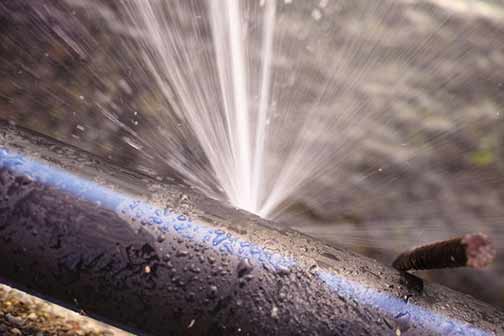
Your main water line may be the most important feature of your home’s plumbing. This is the large pipe that carries water from the public water supply into your home. Without the main water line, all the plumbing fixtures and water-utilizing appliances in your home will not work, says Vesta Management Group.
On average, a typical American home uses around 300 gallons of water every day and all of this water must flow through the home’s main water line. As a result, the main water line is under constant pressure from two sources: the water running inside it and the soil surrounding it.
Consequently, it is not uncommon for your main water line to start showing signs of trouble as the pipe materials lose their quality and slowly degrade. These problems can lead to a leak. If your main water line is leaking, how do you find and fix the problem?
Signs that your main water line is leaking
- Low water pressure in your home is one of the surest signs of a main water line leak.
- Frequent clogs in your water/drain lines because of soil infiltration into the main water line.
- Discolored water as a result of soil and debris finding its way into the pipe.
- Higher water bills that are not the result of increased water usage in your home.
- Wet areas inside your home, usually close to a wall that houses a water line.
- Water puddles outside your house; especially if the puddle is large with water running into the street.
How to find a main water line leak in your home
Except for one or two items on the list, the above signs are not peculiar to main water line leaks. A leak inside your home can also cause some of these problems. To determine if a leak is in your indoor pipes or the main water line, do these steps:
- On your water meter, check for a blue snowflake dial or a red triangular dial.
- This is the valve that shows if water is flowing through the pipe into your home.
- Make sure the valve is moving; a sign that water is flowing into the home.
- Turn off the water supply to your house at the main water shut-off valve.
- Go back and check the water meter to see if the red or blue dial is still moving.
- If it is moving, you leak your main water line.
- It has stopped moving, the leak is probably in a pipe inside your home.
This test only shows you if you have a leak in your home. It does not reveal the exact location of the problem; it tells the general location of the leak. To find the exact spot that is leaking in your main water line, you need advanced testing by a professional plumber.
How to fix a main water line leak
Contrary to what some homeowners think, a leak in your main water line is not the responsibility of the water company. The section of water pipe that runs from your property line into your house is your sole responsibility. Here is how to fix a leak in your main water line:
- Contact a professional plumber with expertise in these kinds of plumbing problems.
- The plumber will want to do more testing to verify that there is a leak and also to find its exact location. They may use a sonar tool to do this.
- Depending on the site of the leak, the plumber will need to do a lot of digging. The exact depth will depend on the level of the frost line in your area.
- If there is a concrete surface above the area where the leaky pipe is, it will have to be cut.
- Before excavation, the water supply to your home will be turned off at the mains.
- Once the leaking pipe section is found, the plumber will turn on the mains to check.
- The leak in your pipe should be immediately obvious once the mains are turned on.
- After this, the mains are turned off again and repairs can commence.
- To fix the leak in the water line, the damaged pipe section is removed and replaced with a short piece of new pipe (after installing a collar and elbow, if necessary).
- After the pipe is connected the mains is opened to verify that the pipe is no longer leaking.
- Finally, the hole is backfilled with dirt. If there is a concrete surface in the area, it is repaired.
The last but not least important part of solving this problem is knowing how to prevent future leaks. The two major causes of main water line leaks are aging and poor maintenance.
These two issues can be managed if you have a schedule for testing and inspecting your plumbing at least once a year.
This step, if done by a professional plumber, can give you forewarning of imminent problems in the water line and help you avoid costly plumbing emergencies in your home.


